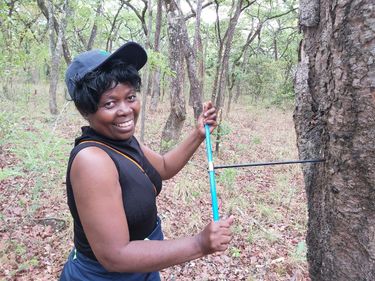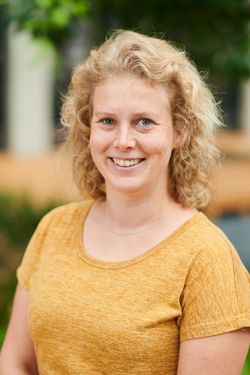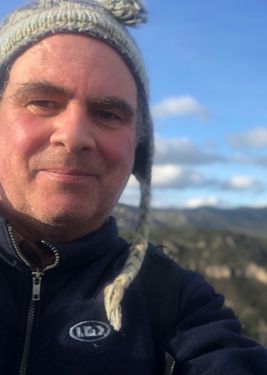
Claudia Fontana
Sessions in which Claudia Fontana participates
Wednesday 29 June, 2022
Recent studies have shown that long-lived tropical trees are able to recover from senescence stages and maintain high rates of aboveground carbon and biomass accumulation throughout their life span. In this study, we present a tree-ring-based analysis to estimate the annual accumulation of aboveground biomass (AGB) and carbon (C-accumulation) of an Ocotea porosa tree over the last five centuries (1485–2016). The study site is located in southern Brazil, under a subtropical climate. AGB was...
Sessions in which Claudia Fontana attends
Monday 27 June, 2022
Blue Intensity (BI) is a cost-effective analytical method for measuring relative wood density in the rings of conifer tree species. Since early concept papers in the 1990s/2000s, there has been a recent explosion in the application of this method for both dendroclimatology and historical dating as well as other dendro-disciplines. The beauty of BI is that the analytical costs, mainly related to the cost of a h...
Blue Intensity (BI) is a cost-effective analytical method for measuring relative wood density in the rings of conifer tree species. Since early concept papers in the 1990s/2000s, there has been a recent explosion in the application of this method for both dendroclimatology and historical dating as well as other dendro-disciplines. The beauty of BI is that the analytical costs, mainly related to the cost of a h...
Tuesday 28 June, 2022
Africa is faced with a number of challenges including climate change and ecological disturbance due to various anthropogenic activities. These problems adversely affect the forests and also ecosystem services. My appreciation for the forests motivated me to pursure my undergraduate studies in Forestry. I first applied dendrochronology during my PhD research which focused on understanding the climate change vulnerability of the Zambezi teak forests in Zambia. However, lack of research facil...
Although numerous proxy-based climate reconstructions have been developed and despite the prevalence of relatively long instrumental records throughout Europe, reliable information about past climate is still lacking in some regions, particularly eastern parts of the continent. This issue is linked to limitations in data quality and large uncertainties in existing records. The REPLICATE project aims to fill this spatial paleoclimatic and data quality gap by applying a tree-ring multi-param...
Wednesday 29 June, 2022
Dendrochronology is considered one the most precise of all the scientific dating techniques. However, it requires long sequences of tree rings and a master record for both the species and region in question. At the University of Groningen, we have been pioneering a new approach to dating that combines the precision of dendrochronology with the versatility of radiocarbon dating. It relies on the detection of spikes in the annual radiocarbon record, thought to b...
Information garnered from historical timbers and wooden artifacts (e.g. houses, barns, ships) can greatly enhance our understanding of human, ecological, and climate history, especially in regions where few old-growth forests and trees remain, tree longevity is relatively short (less than 300-400 years), and environmental conditions break down wood rather quickly, like in mesic to wet regions. Over the last decade plus, the application of tree-ring techniques on wo...
Hydroclimate variability in tropical South America is strongly regulated by the South American Summer Monsoon (SASM). However, past precipitation changes are poorly constrained due to limited observations and high-resolution paleoproxies. We found that summer precipitation and the El Niño-Southern Oscillation tarapacana (ENSO) in the Chilean variability and Bolivian are well registered Altiplano in in tree-ring the Central stable Andes oxygen (18–22°S, isotopes ∼4,500 (δ18OTR) m a.s.l.) of...
Increasing frequency of droughts strongly affect the available soil water. Lower water availability was often reported to reduce radial growth not only in climate-limited, but also in optimal areas of tree species distribution. Sampling strategies in dendrochronology focus on specific sites, often in climate-limited conditions. Using tree ring samples collected within National Forest Inventories provides an opportunity to assess growth-climate responses statistically representative o...
Oxygen isotope ratios in tree rings (δ18OTR) from Amazon forests have been shown to provide historical records of rainfall amounts at a large scale, due to the rainout of heavy isotopes during moisture transport. Here, we present a 110-year oxygen isotope record obtained from tree ring-cellulose of six Cedrela odorata trees (rbar = 0.57, EPS = 0.89) from the region of Tapajos River, Eastern Amazon. Our analysis indicates that δ18OTR series reflects inter-annual variability of wet season (J...
It has been shown that trees get older in the wet tropics, but the mechanisms behind this observation are still not clear. Literature shows that moisture could directly affect longevity by modulating physiological processes of trees. Other studies point to the potential role of water on tree size, which could indirectly affect longevity if one reconciles to the fact that the growth rate of tropical trees doesn’t differ significantly between wet and dry sites. The third group points to the ...
Central Europe has been affected by unprecedented summer droughts in the 21st century, resulting in large-scale forest decline that has impacted many native tree species. Growth analyses of multiple tree species from mid to low elevation in Europe remain sparse, despite decades of dendroclimatological studies, and limit our understanding of how forests will evolve under changing climate conditions. Here, we introduce a new multi-species tree-ring width network of 65 individual sites (>2...
Anthropogenic climate warming is altering the ecosystem function of temperate and boreal forests. A number of studies have indicated a rise in overall ecological productivity due to a lengthening growing season, particularly into early spring. However, interactions between temperature and precipitation remain understudied with respect to their combined impacts on the responses of trees to warming in spring. Here, I examine the sensitivity of common Midwestern conifers to multiple dimension...
Water scarcity is a major 21st century challenge that is increasing the vulnerability of the human population, especially in cities. Water risk assessment is a fundamental task in many cities worldwide that often lack long-term and spatially-resolved records of precipitation and level of water reservoirs. Past rainfall and reservoirs levels may be alternatively assessed using tree-ring stable isotopes of urban trees. We assessed the past variability of precipitation and reservoirs level th...
To estimate the effects of a warmer and drier future climate on mountain forests, we analyzed the climate response of radial growth of five different conifer species along elevation transects between 1070 m and the forest line near 2400 m above sea level within an inner-alpine dry valley in the LTSER area Matsch|Mazia in Northern Italy. For additional information in growth processes and tree hydraulics automatic dendrometer measurements were used. As expected, we generally observed positiv...
Stable carbon (δ13Cc) and oxygen (δ18Oc) isotopes in tree-ring cellulose, and tree-ring width (TRW), have been used extensively to investigate the effects of climate on tree growth. By contrast, the information recorded by the non-exchangeable carbon-bound hydrogen (δ2Hc) isotopes, has been far less explored. To create a comprehensive assessment of δ2H potential as a proxy for climate, hydrology, plant metabolism, and physiology we explored its relationships with climate an...
Here we report shrub-ring isotope records for big sagebrush (Artemisia tridentata) from below the “reverse treeline” in central Utah, USA. Despite sectorial growth, ring-widths of mature plants (age range 9 to 54 years) cross-dated well. Plants were sampled in upland locations (controls) as well as adjacent to mounds (circular patches of denuded soil approximately five m diameter) made by harvester ants (Pogonomyrmex occidentalis) and in swale locations where water drains during monsoon ra...
The main objective of this project is to quantify the increased productivity of Betula glandulosa Michx in Umiujaq, Nunavik, northern Quebec and evaluate how climatic and edaphic conditions influence this change. The speed at which climate change is affecting the northern ecosystems remains poorly understood and data are needed to anticipate future ecological and physiological trajectories of the vegetation. We produced a tree-ring chronology from approximately 40 specimens of Betula gland...
Fire-dependent red pine (Pinus resinosa Ait.) vegetation communities in the central Appalac...
Forest management options aimed at mitigating the rate of increase in atmospheric concentrations of CO2, include thinning and partial harvesting to increase growth and carbon (C) capture of residual trees as a stand matures. Variable retention harvesting (VRH) can be used to increase forest growth rates and C sequestration, while enhancing biodiversity and resilience. Across southern Ontario, Canada, numerous plantations were established in the early 20th century on abandoned agricultural ...
Dendroclimatology in the tropical forest regions has lagged behind the more temperate forested regions of the world because of the challenge of determining annual ring formation. Despite over 230 tropical tree species known to form annual rings, the ITRDB shows few published chronologies in tropical forests in Sub-Saharan Africa. As part of the first “Training in Tree-Ring Science and its Applications” workshop conducted in Kitwe, Zambia, our team explored the dendroclimatic potential of B...
"Multi-centennial to millennial-long oak ring width chronologies from living and relict wood are frequently used for climate reconstructions, but the amount of explained hydroclimatic variation remains relatively small. Although stable carbon and oxygen isotopic ratios (δ13C and δ18O values) in tree rings may offer enhanced climate sensitivity, our understanding of their paleoclimatic sensitivity is still limited by the general lack of well-replicated and high-resolution datasets. Here, we...
Session reescheduled from June 28th to June 29th
Rescheduled from June 28th to June 29th
Ring-width (RW) and Blue Intensity (BI) parameters (earlywood - EWB, inverted latewood – LWBinv, and delta - DB) were measured from samples of Araucaria araucana from six sites in northern Patagonia, Argentina. The distance between the most southerly and northerly sites is ca. 130 kms. Despite a much weaker between-tree signal for the BI parameters than RW, principal component analysis identifies a much stronger regional between-site signal for the BI parameters. Split period correlation r...
This is a mandatory (!) .... and FREE (!!) cocktail & award ceremony (!!!)(in replacement of the Banquet formula)->->->->->->->->->->->->->->->->->->After a great summer day of scientific and urban discoveries in our beloved MTL, we wish to bring together all the AmeriDendro community in one place and congratulate the TRS awardees for their remarkable achievements! -Bonsinsegna award-Fr...
Thursday 30 June, 2022
How old are tropical trees? This fundamental question has long driven the curiosity of laymen and scientists. But only recently, a great number of studies conducted by many brave dendrochronologists resulted in a significant tree-ring-based knowledge that allows us to start accurately estimating tree ages across the globe. As science goes, not only knowing the longevity of tropical trees is essential to understanding forest dynamics and its role in biogeochemical cycles, but one must also ...
Dendrochronological archives in the tropics of the Americas have been under-studied for a long time. Some of the challenges include the Identification of tree-ring boundaries in certain tree species, absence of winter dormancy associated to low temperatures in most of the cases, and logistic difficulties of fieldwork in remote sites. However, part of the slow progress is also related to the fact that historically much less resources have been inv...
Dendrochronological archives in the tropics of the Americas have been under-studied for a long time. Some of the challenges include the Identification of tree-ring boundaries in certain tree species, absence of winter dormancy associated to low temperatures in most of the cases, and logistic difficulties of fieldwork in remote sites. However, part of the slow progress is also related to the fact that historically much less resources have been inv...
A gap of millennial tree-ring data suitable for dendroclimatology has long been evident in the North American boreal forest. In my talk, I will describe the adaptive approach we have developed to build and improve a data network for millennial dendroclimatology in the eastern Canadian taiga. Recurrence of stand replacing wildfires is the most important constrain to the elaboration of long tree ring chronologies, which can only be developed away from regions ...
The interpretation of stable isotopes in a dendroecological framework can provide powerful insights into how trees adjust physiologically in response to the environment. This symposium aims to bring together researchers who use stable isotopes in tree rings to address ecophysiological responses to environmental changes from intra-annual to multi-decadal resolution. We hope this symposium will enable fruitful discussions and new ideas a...
Allies have emerged as key enablers of diversity and inclusivity initiatives in the workplace, in professional associations, and in everyday life. But what is an ally? What skills are required to be an effective ally? How do we hold ourselves and our community members accountable for being effective allies? This symposium will provide a deeper understanding of what it means to be an ally and the skills to help advance allyship as individuals and as a community. Fur...
(by bus, max 92 people)Designed for visitors and newcomers, the tour is based on the pleasure...




